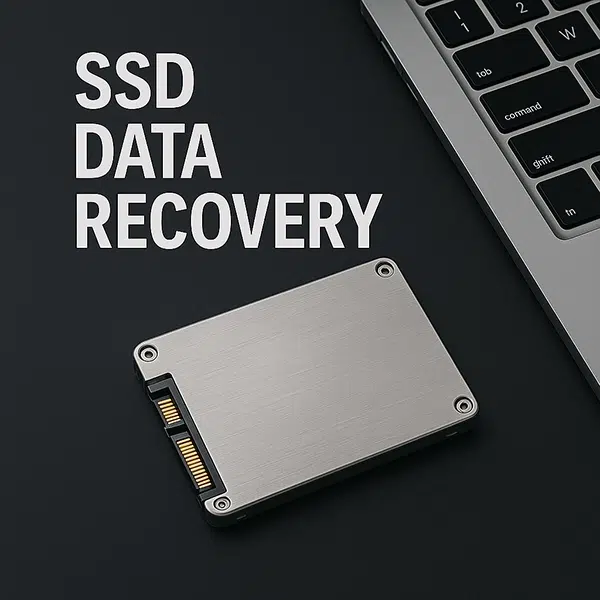If you have lost data from an SSD for whatever reason, Data Recovery Lab can help you. All you need to do, is bring your SSD to us without further ado and we will certainly and happily be able to help you. We will ensure the end result is successful and will make you smile when you see your data again! Call 02075161077 to book an appointment or for any help on SSD data recovery.
Expert SSD Data Recovery Services in London
Have you lost access to critical files on your SSD? At Data Recovery Lab London, we specialise in professional SSD Data Recovery for individuals, businesses, creative professionals, and law firms across the UK. Using advanced equipments and specialist tools (including PC-3000 SSD), our certified engineers recover data from SATA, mSATA, M.2 NVMe, PCIe and external USB SSDs with industry-leading success rates.
Even if your SSD is completely dead, our advanced equipment allows us to dump the chip and read data directly from the memory chip itself.
With over 20 years of experience, GDPR-compliant processes, and a simple No Data, No Fee guarantee, we are recognised as one of London’s most trusted SSD recovery labs. Whether the issue is logical corruption, controller failure, firmware faults, or physical damage, we restore your data quickly, securely, and confidentially.

Why Choose Our SSD Data Recovery Service?
- No Data, No Fee – you only pay upon successful recovery
- Free Collection
- Free assessment with a transparent quotation
- Competitive Price
- Specialists in SATA, mSATA, M.2 NVMe, PCIe and external USB SSDs
- Support for all major brands: Samsung, WD, SanDisk, Crucial, Kingston, Seagate, Intel, Transcend and more
- Advanced cleanroom facilities, PC-3000 SSD, chip-off NAND and micro-soldering
- Trusted by media companies, photographers, production houses, IT teams, law firms and private clients
- London-based laboratory with strict confidentiality and full GDPR compliance
Common SSD Failure Scenarios
SSD data can become inaccessible for many reasons, including:
- Controller/firmware failure: drive not detected, 0 MB capacity, or stuck in read-only mode
- File system corruption: drive asks to be formatted, OS won’t mount the volume
- Bad blocks / NAND wear: very slow reads, frequent I/O errors, blue screens
- Power surge or ESD: sudden failure after power cut or adapter fault
- Physical/ liquid damage: burnt components, corrosion, cracked PCB
- Accidental deletion / quick format: files removed or partition lost (see TRIM notice below)
Types of SSDs and Interfaces We Support
- 2.5″ SATA, mSATA, M.2 NVMe (PCIe), M.2 SATA, U.2, and PCIe add-in card SSDs
- External SSDs (USB-C/USB-A enclosures), portable drives, and proprietary OEM modules
- Windows (NTFS), macOS (APFS/HFS+), Linux (EXT/XFS/BTRFS), exFAT/FAT
Failure Types, Symptoms & Recovery Outlook
Here’s a quick guide to common SSD issues and recommended actions:
| Failure Type | Typical Symptoms | What You Should Do | Recovery Outlook* |
|---|---|---|---|
| Firmware/Controller fault | Not detected, 0 MB capacity, freezes | Power off; do not reflash firmware | Good with specialist tools |
| Logical corruption | Volume won’t mount; asks to format | Avoid chkdsk/fsck; seek diagnosis | High if no write attempts |
| Bad blocks / NAND wear | Slow I/O; read errors | Stop heavy use; image with pro tools | Moderate to high |
| Power surge / liquid damage | No power; burnt smell; shorted board | Do not power again; keep dry | Variable; often possible |
| Accidental deletion / quick format | Files/partitions missing | Immediately power off | Variable (see TRIM note) |
TRIM notice: On modern SSDs, deleted blocks may be TRIM-cleared by the OS, making some deletions unrecoverable. Powering off immediately after data loss offers the best chance. Avoid writing new data to the SSD.
Our SSD Data Recovery Process
- Free assessment: We evaluate the SSD and interface (SATA/NVMe) and identify the failure type.
- Quotation: You receive a clear, no-obligation estimate before any recovery begins.
- Imaging: We create a safe, sector-by-sector image using write-blocked tools to protect data.
- Logical rebuild: File systems and partitions are reconstructed; lost folders are rebuilt.
- Physical/firmware repair: Where required, we use PC-3000 SSD, chip-off NAND, or component-level work.
- Verification: Recovered files are checked for integrity and sample-opened (where applicable).
- Secure return: Your data is delivered on a new drive or encrypted media as requested.
Who We Help
- Businesses & IT teams: laptops, desktops, and external SSDs with critical documents
- Photographers & creatives: Lightroom libraries, RAW shoots, project files
- Developers: source code, VMs, and project repositories
- Law firms & investigators: case files and time-sensitive evidence
- Private individuals: personal photos, videos, and important records
Best Practices After SSD Data Loss
- Power off immediately. Continued use can trigger background TRIM and wear-levelling writes.
- Do not run repair tools (chkdsk, fsck, Disk Utility First Aid) before a professional assessment.
- Do not open the enclosure or attempt firmware updates.
- Contact a professional recovery lab as soon as possible.
Related Services
- Hard Drive Data Recovery
- RAID & NAS Data Recovery
- Mac Data Recovery (APFS)
- External Drive Recovery
- SD Card Data Recovery
- Media & Memory Card Recovery
- USB Memory Stick Data Recovery
Frequently Asked Questions (FAQ)
Can you recover from NVMe (M.2) SSDs?
Yes. We regularly recover from NVMe drives used in modern laptops and desktops.
Can deleted files be recovered from an SSD?
Sometimes. If TRIM has cleared the blocks, recovery may be impossible. Power off immediately and contact us.
How long does SSD recovery take?
Most cases complete in 1–7 working days. Severe or physically damaged cases may take longer. Priority services are available.
Is my data confidential?
Absolutely. All work is carried out under strict GDPR and confidentiality protocols.
What media do you return the data on?
We can supply a new USB drive or SSD. Encrypted delivery options are available.
CONTACT DATA RECOVERY LAB Today
Phone: 020 7516 1077
Email: info@datarecovery.london
Address: Euro House, 133 Ballards Lane, London, N3 1LJ
We provide professional SSD data recovery services across the UK and Europe, trusted by individuals, companies, and law firms.
Request a Quote Make an Appointment
SSD Data Recovery and How We can Help You
What is an SSD?
SSD stands for Solid State Drive. SSDs are essentially are disks which store computer data. Traditional disks are generally made up of mechanical parts and electronic components which spin while reading and writing computer data. That is why they make a whirring noise when reading and writing data. On the contrary, SSDs do not have any mechanical bits and they are all made of electronic circuits. This means they can come in all sorts of shapes and types. Some SSDs look like traditional hard drives while others look like computer memory modules.

How do SSDs work and how different are they from traditional disks?
SSDs (Solid State Drives) are made of a controller chip or CPU which manages the flow of data in and out of the data storage memory modules soldered onto the the SSD electronic circuit. The controller chip on board also manages the power to the data storage chips. Depending on the data capacity of the SSDs, there may be 2 or more data chips. As SSDs do not have any mechanical parts, they do not make any noise and do not fail if you drop them.
SSD data recovery can be challenging due to their complex nature in data storage and preservation. The good thing about them is that they are fast, very responsive in read/write operations and they are also shock-resistant therefore, do not get damaged when dropped as opposed to traditional mechanical drives which are slower and prone to failure if you drop or shock them. However there are downsides to SSDs as they are not perfect. First of all, data storage in SSD is fundamentally different from mechanical drives. To have a larger size, the manufacturers have to design circuits to accommodate more chips on board and then they have to write software on how to manage data across multiple data chips. This means they have to create actual RAID arrays of individual chips. Therefore, formatting an SSD can be problematic in data recovery as SSDs do not behave in the same way as the traditional disks do. In addition to this, SSDs are purely made of electronic circuits and software managing the circuit. Therefore, if any individual data chip in the array fails or the software in the data controller chip gets corrupted, the entire data volume will be brought down leading to data loss. This makes the reconstruction of the data volume and the file system very challenging and difficult. Another issue is wear and tear and degradation of the chips after 3-5 years depending on the quality of the silicon used in manufacturing the the SSD as opposed to good quality electro-mechanical disks which have a longer shelf-life as long as they are not subjected to shock or drop.

How does SSD data recovery process work?
As most computers and digital devices use SSDs for data storage, their usage is already overtaking the use traditional of electro-mechanical disks. Because of the prevalence of SSD in laptops, desktops and servers and others devices, you may experience data loss as a result of SSD failure. Therefore, SSD recovery is required so that you can regain access to your data. As SSDs store data differently compared to electro-mechanical disks, SSD data recovery is also conducted differently. Initially, the SSD data recovery specialist will attempt to repair the electronic circuit of the SSD. If this does not lead to a successful SSD recovery, then off-the-chip SSD recovery becomes essential. In this method, all the data memory chips are extracted from the circuit and labelled.
Then the contents of each chip is dumped onto an SSD recovery workstation using a special device called a “chip reader”. When all the contents of all the data chips have been uploaded onto the workstation via the chip reader, all the data dumps are organised like a jigsaw so that a full image of the SSD data volume is obtained. This is done by using specialist SSD recovery tools not generally available to the general public. If the SSD is secured by encryption, the data volume must be decrypted by using the user password. Once the data volume is reconstructed from the data dumps and deciphered, SSD recovery technicians transfer the data onto a healthy external disk and prepare it for delivery or collection by the customer.
“I have an SSD drive from a Mac, can you recover data from it?”
Yes we can. Data Recovery Lab technicians are trained to recover data from all types of SSD including the ones from Apple Computers like iMacs, MacBook Pros and MAcBook Airs as well as Windows laptops, desktops and gaming computers. We have performed successful SSD data recovery on numerous disks since they appeared. SSD data recovery despite its complexity, is assured and we will be able to recover data from 9 out of 10 faulty SSDs. We have a well-equipped SSD Data recovery Lab in Finchley in London. All you need to do, is bring your SSD to us for data recovery.
“What if my SSD is not electronically sound but I have lost data because I deleted the files or format the SSD by accident?”
Yes we can! We will still be able to recover data from an SSD whose data has been deleted or the data volume has been accidentally formatted. Important note! Do NOT do any DIY data recovery or write any data onto the SSD disk otherwise you will overwrite the space used by the deleted data and SSD data recovery may not be successful.


